The Arran whitebeams are species of whitebeam endemic to the island of Arran, Ayrshire, Scotland.

Sorbus anglica, the English whitebeam, is a species of whitebeam tree in the family Rosaceae. It is uncommonly found in Ireland and the United Kingdom, with an entire British population estimated at about 600 individuals.

Karpatiosorbus bristoliensis is a species of flowering plant in the family Rosaceae. It is known commonly as the Bristol whitebeam. It is endemic to Great Britain, growing wild only in the Avon Gorge and in the Leigh Woods area of Bristol. There are around 300 individuals as of 2016, and the population is thought to be increasing.
Sorbus decipiens, the sharp-toothed whitebeam, is a species of plant in the family Rosaceae. It is endemic to Germany.

Sorbus eminens, the round-leaved whitebeam, sometimes classified as Aria eminens when the Aria subgenus of Sorbus is elevated to full genus, is a species of plant in the family Rosaceae. It is endemic to Great Britain. It is threatened by habitat loss.
Sorbus lancastriensis, the Lancastrian whitebeam, is a species of deciduous tree or shrub in the family Rosaceae, growing to 6 m (20 ft). It is endemic to England, and is found within a 30 km (19 mi) radius from Morecambe Bay, in Lancashire. It is threatened by habitat loss. It has oval leaves. White blossom in spring is followed by orange to red berries in autumn.
Sorbus leptophylla, the thin-leaved whitebeam, is a species of plant in the family Rosaceae. It is endemic to Wales.
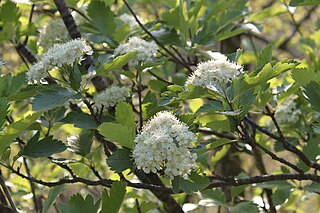
Sorbus leyana. Ley's whitebeam, is a species of small tree which is endemic to two sites in southern Wales. It is thought to have arisen by hybridisation of two species of Sorbus, one of which was the rowan. Its closest relatives are some of the other hybrid derived Sorbus species found in Britain.
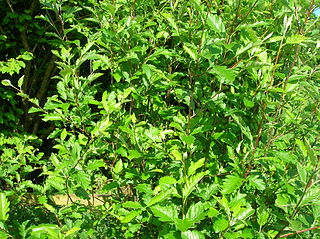
Sorbus pseudofennica is a species of plant in the family Rosaceae. Endemic to the Isle of Arran in Scotland, it is threatened by habitat loss. It is thought to be a naturally occurring hybrid between S. arranensis and S. aucuparia, probably with additional backcrossing with S. aucuparia. Sorbus arranensis is itself a hybrid between S. rupicola and S. aucuparia. Apomixis and hybridization are common in some groups of Sorbus species.
Karpatiosorbus subcuneata, the Somerset whitebeam, is a species of plant in the family Rosaceae. It is endemic to coastal north Devon and west Somerset in the United Kingdom. It is threatened by habitat loss.
Sorbus wilmottiana, the Willmott's whitebeam, is a species of whitebeam in the family Rosaceae. It is endemic to England, and is found in the Avon Gorge, in Somerset and Gloucestershire. It is threatened by habitat loss.
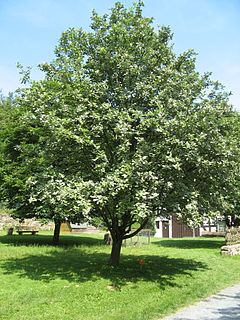
Sorbus aria, the whitebeam or common whitebeam, is a deciduous tree, the type species of the subgenus Sorbus subg. Aria of the genus Sorbus. It is native to most of Europe as well as North Africa and temperate Asia. Typically compact and domed, with few upswept branches and almost-white underside of the leaves, it generally favours dry limestone and chalk soils. The hermaphrodite cream-white flowers appear in May, are insect pollinated, and go on to produce scarlet berries, which are often eaten by birds.
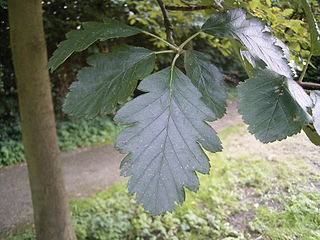
Sorbus intermedia, the Swedish whitebeam, is a species of whitebeam found in southern Sweden, with scattered occurrences in easternmost Denmark (Bornholm), the far southwest of Finland, Estonia, Latvia and northern Poland.

Sorbus × hybrida, the oakleaf mountain ash, Swedish service-tree or Finnish whitebeam, is a hybrid species of whitebeam native to Norway, eastern Sweden, southwestern Finland, and locally in Latvia.
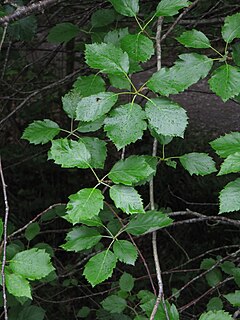
Karpatiosorbus admonitor, previously classified as Sorbus admonitor and also called the no parking whitebeam, is a species of whitebeam tree found in Devon, United Kingdom. Known only from the Watersmeet Valley at Lynton, with two stray plants growing on the coast above Sillery Sands, Countisbury.

Karpatiosorbus devoniensis is known by the English name of Devon whitebeam and formally as Broad-leaved Whitebeam. When the fruit was reported as sold at Barnstaple Pannier Market the name French Eagles was used, apart from 1929 when they were reported as eagle-berries. When the trees were reported as seen growing wild on botanical walks they were referred to as French Hails. Broad-leaved white-beam, which was the common name until Devon Whitebeam took over, was used once in 1907. The term Otmast was used once as a pet name, as its true identity was not known. It is a species of whitebeam, trees and shrubs in the family Rosaceae. It is endemic to the British Isles, growing wild in areas of Devon, Cornwall, Somerset and south-east Ireland as a native and north-east Ireland as an introduction.
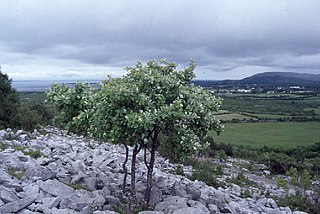
Sorbus hibernica, the Irish whitebeam, is a species of whitebeam endemic to Ireland. It occurs in most counties, usually as scattered individuals, or in small groups. It is sometimes treated as a species in the genus Aria, as Aria hibernica.
Sorbus porrigentiformis, the grey-leafed whitebeam, is a species of whitebeam endemic to England and Wales.
Sorbus leighensis, the Leigh Woods whitebeam, is a rare species of whitebeam, a flowering plant in the rose family.
Sorbus arvonensis, called the Menai Strait whitebeam or Cerddin Menai, is a whitebeam species in the rose family. It is native to a restricted area along the shore of the Menai Strait in North Wales. The species was first described by Sell (2014) and has been assessed as Critically Endangered.











